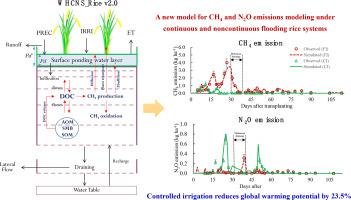Agricultural Systems ( IF 6.1 ) Pub Date : 2022-09-29 , DOI: 10.1016/j.agsy.2022.103528 Hao Liang , Junzeng Xu , Huijing Hou , Zhiming Qi , Shihong Yang , Yawei Li , Kelin Hu

|
CONTEXT
Noncontinuous flooding irrigation is an important means of reducing water use, mitigating greenhouse gas emission, and maintaining crop yield in rice production systems. Quantifying the CH4 and N2O emissions in continuous and noncontinuous flooding irrigation systems is crucial to the exploration of sustainable water management practices in rice systems.
OBJECTIVE
In this study, a simple “anaerobic ball” method was incorporated into the WHCNS (soil Water Heat Carbon Nitrogen Simulator) model to simulate and evaluate the CH4 and N2O emissions under continuous and noncontinuous flooding irrigation conditions.
METHODS
This model considers the processes of dissolved organic carbon (DOC) release and transport in the soil profile, CH4 production, oxidation, and transport, and N2O production, reduction, and transport. Three years of field experiment data, including soil and environment variables (e.g., ponding water depth, soil water content, and soil temperature) and daily CH4 and N2O emission fluxes under different irrigation practices were collected to test the improved WHCNS model.
RESULTS AND CONCLUSIONS
Results show that the model performs well in simulating soil and environment variables, with performance indices IA, NSE, and Pearson's r varying from 0.772 to 0.966, 0.530–0.853, and 0.780–0.934, respectively. Furthermore, the daily dynamics of CH4 and N2O emissions were captured under different rice irrigation systems, with average IA, NSE, and Pearson's r values of 0.857, 0.476, and 0.763, respectively. The observed and simulated results indicate that noncontinuous irrigation reduces CH4 emission but increases N2O emission. Compared with continuous flooding irrigation, noncontinuous flooding irrigation significantly decreased the accumulated CH4 emission by 82.1%, but significantly increased the N2O emission by 129.4%, resulting in the global warming potential reduction of 23.5%.
SIGNIFICANCE
The improved model reflects the effects of continuous and noncontinuous flooding practices on CH4 and N2O emissions, and exhibits great potential for the development of sustainable water management for rice production systems.
中文翻译:

模拟连续和非连续灌溉水稻系统的 CH4 和 N2O 排放
语境
非连续漫灌是水稻生产系统中减少用水、减少温室气体排放和保持作物产量的重要手段。量化连续和非连续漫灌系统中的 CH 4和 N 2 O 排放对于探索水稻系统的可持续水管理实践至关重要。
客观的
在本研究中,将一种简单的“厌氧球”方法结合到 WHCNS(土壤水热碳氮模拟器)模型中,以模拟和评估连续和非连续漫灌条件下的 CH 4和 N 2 O 排放。
方法
该模型考虑了土壤剖面中溶解有机碳 (DOC) 的释放和迁移过程、CH 4的产生、氧化和迁移过程,以及 N 2 O 的产生、还原和迁移过程。收集了三年的田间试验数据,包括土壤和环境变量(如积水深度、土壤含水量和土壤温度)以及不同灌溉方式下的每日 CH 4和 N 2 O 排放通量,以测试改进的 WHCNS 模型。
结果和结论
结果表明,该模型在模拟土壤和环境变量方面表现良好,性能指标IA、NSE和Pearson 的 r分别在 0.772 到 0.966、0.530–0.853 和 0.780–0.934 之间变化。此外,捕获了不同水稻灌溉系统下CH 4和N 2 O 排放的每日动态,平均IA、NSE和Pearson r值分别为0.857、0.476 和0.763。观察和模拟结果表明,非连续灌溉减少了 CH 4排放但增加了 N 2O 排放。与连续漫灌相比,非连续漫灌显着降低了累积CH 4排放量82.1%,但显着增加了N 2 O 排放量129.4%,使全球变暖潜势降低了23.5%。
意义
改进后的模型反映了连续和非连续驱水方式对 CH 4和 N 2 O 排放的影响,显示出发展水稻生产系统可持续水资源管理的巨大潜力。











































 京公网安备 11010802027423号
京公网安备 11010802027423号